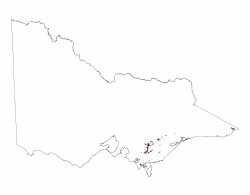7.3.3 Dissected plains (Yallourn North, Inverloch)
7. Eastern Plains (EP)
7.3 High level terraces and fans
| The dissected plains are similar to the plains described under 7.3.1 in that they too are comprised of Neogene sediments derived from the Eastern Uplands. After the deposition of these sediments, later streams have incised into the former plains, resulting in a landform best described as undulating to rolling low hills. The soils that have developed on these plains all have a bleached subsurface soil (A2 horizon). Most of the soils are acidic and lack texture contrast (Dermosols), but in south Gippsland east of Inverloch they are texture contrast acidic soils (Kurosols) with some of the sandier surface soils developing “coffee rock” layer at the base of the A2 horizon. The climate is humid, with annual rainfall exceeding 700 mm. As a consequence the vegetation was originally mainly forest (plains grassy forest, lowland forest) with areas of grassy woodland/swamp scrub. The predominant land use is now grazing. |  |


